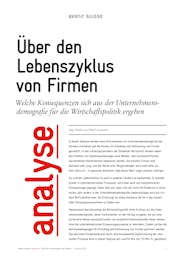Each year a considerable proportion of companies disappear from the market and are replaced by new ones. The Swiss economy is no different in this respect. Avenir Suisse has for the first time created “age pyramids” for corporations. These show not only the effects of changes in the law, but reveal the median and average ages of various types of legal entity.
The finding is that most companies are very young, with half of all new start-ups not surviving beyond five years. In some sectors the figure is much lower. In hotel and catering, for example, half of all businesses no longer exist three years after their establishment.
How the Covid-19 crisis is affecting corporate demographics
Corporate life cycles are primarily rooted in entrepreneurial processes, but are also influenced by fluctuations in the economic cycle. For example, more companies generally disappear from the market in times of crisis than during periods of normality. What’s striking is that in its first year the Covid-19 pandemic will have a different impact on corporate demographics than previous economic crises. This is indicated by current bankruptcy data.
A comparison with the 2008 financial crisis and the 2015 Swiss franc shock shows the number of bankruptcies in 2020 to be well below average. The reason for this lies in extensive federal and cantonal support measures targeting companies directly.
Authorities’ costly refusal to leave analog structures behind
The latest measures around the pandemic aren’t the only way politicians are influencing corporate demographics. Changes to company law are also leaving their mark on the age pyramid. Whether corporate life cycles entail high or low costs ultimately depends on the design of the interface between business and government.
Switzerland has repeatedly performed poorly in international rankings of this interface. In its latest study, Avenir Suisse estimates the economic costs of the constant coming and going of companies at around CHF 100 to 230 million a year. Given that various expenses (applications for social security, VAT, etc.) are not included, the study represents only costs in the narrow sense of the word.
Need to optimize economic policy and the framework
There seems to be little public awareness of the fact that so many companies are short-lived. But the implications are significant.
- In the course of this year, economic policy should move out of crisis mode and return to established mechanisms. Institutions such as unemployment insurance and the short-time working mechanism have evolved historically and are balanced accordingly. Automatic stabilizing mechanisms of this sort are a good way of mitigating hardship in individual cases and reducing fluctuations in the economic cycle.
- Action needs to be taken on the government framework around corporate life cycles. In this respect, structures in Switzerland remain stuck in the analog age. Systematic digitalization of bureaucratic processes could do a lot to reduce the administrative burden on Swiss companies. Even within the narrow field of corporate start-ups and closures, this study estimates potential savings of between around CHF 52 and 113 million a year.






